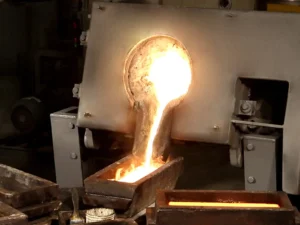Many industries melt aluminum and use it to manufacture various products. However, many people don’t know the exact temperature at which the aluminum starts melting.
The melting point of aluminum in its pure form is 660 degrees Celsius (1220 degrees Fahrenheit). However, users generally employ it with alloys, so its M.P. varies from pure form. It is due to impurities present in alloys and the mixing of other elements with aluminum.
Aluminum is one of the most used metals, and it is even present in almost every home in the form of households. This guide will give you all the information about the temperature for melting aluminum.
Related: Melting Point of Different Metals
Melting Point of Aluminium and its importance

The melting point is the temperature at which the metal (take it aluminum or any other) changes from solid to liquid. Different metals have different melting points depending on their physical properties.
A metal with a higher melting point will require more energy to break the atoms bonded together and vice versa.
So, At What Temp Does Aluminum Melt? So, At What Temp Does Aluminum Melt? Aluminum metal has a melting point of 660 degrees Celsius. But this is the temperature where the pure aluminum melts. But, this exact temperature would need to be revised for aluminum alloy.
The melting point is not exactly 660 degrees Celsius in aluminum alloys. For example, Copper-aluminum or magnesium-aluminum. They don’t melt at 660°C. The reason is that the alloy element departs its physical properties to the alloy, which alters the melting point.
For example, the melting point of copper aluminum alloy is 500-600°C, not the exact 660°C. You might be wondering: why is it so? This difference is due to the unique physical properties of copper when employed as an alloy with aluminum.
Here is the table that sheds light on the M.P of pure aluminum and some of its alloys:
| Name | Melting Point Range (°C) |
| Commercially Pure Aluminum | 660°C |
| Aluminum-Magnesium Alloy | 540 to 640°C |
| Aluminum-Magnesium-Silicon Alloy | 570 to 630°C |
| Aluminum-Zinc Alloy | 600 to 660°C |
| Aluminum-Manganese Alloy | 640 to 700°C |
Significance of the Melting Point in Aluminum Applications
Knowing the melting point of the metal is very important. The reason is that it helps identify the impurities in the aluminum metal. If aluminum contains some impurities, its melting would be altered and won’t melt at exactly 660°C.
Identifying impurities is critical when using aluminum to produce any specific product. If the aluminum you have melts at 660°C, it is present in its pure form. It does not; it simply indicates that the aluminum has some impurities.
At the industry level, sometimes, you’ll need aluminum in impure form. But, at times, you’ll need the purest form of aluminum. By finding the temperature where it melts, you’ll know whether your aluminum is pure or impure.
What is the Melting Point Depression of Aluminium?

As I said earlier, the exact temperature for melting pure aluminum is known. But, sometimes, aluminum contains impurities. Due to these impurities, the melting point increases, and you won’t get an exact melting point.
Due to impurities, aluminum has a wide range of temperatures. This is called the melting point depression. In such a case, you won’t get an exact temperature; instead, you’ll gain a range of temperatures.
For example, the melting point of magnesium-aluminum alloys ranges between 600-700°C. Due to the presence of magnesium, the aluminum will now melt between 600-700°C instead of melting at 660°C.
Why is the aluminum melting point higher than that of other metals?
The atoms of aluminum metal are strongly held together. But, to melt the aluminum, these atoms have to be separated from each other. Since they are tightly held together, more energy will be required to break them apart.
The energy is provided in the form of heat. So, you’ll offer more heat until the atoms don’t separate from each other. This is why the aluminum metal melting point is so high—firmly held atoms of aluminum break apart at the temperature of 660°C.
Factors Influencing the Melting Point of Aluminium

You might not know that some factors influence the aluminum melting point temperature. In the approaching section, I will shed light on those factors.
1- Alloy Composition
If aluminum is present in an alloy with any other metal, its melting point will differ from its pure form. The reason is that the alloy metal has its physical properties and imparts its properties to aluminum. Due to this, the melting point also changes.
For example, the melting point of aluminum zinc and magnesium alloy is between 605-630°C, not 660°C. This change is due to the physical properties of zinc and magnesium metals.
2- Impurities
An impurity is a component that is not part of the actual metal. Sometimes, aluminum also contains impurities. Due to the presence of these impurities or unwanted substances, the melting point of aluminum changes. If aluminum has more impurities, it will have a higher melting point and vice versa.
3- Force of Attraction & Pressure
Remember that the forces of attraction between the atoms and pressure are important factors. They influence the aluminum melting point temperature. If the aluminum is placed under very high pressure, its melting point will be reduced, and vice versa.
4- Particle Size
The size of the aluminum you will melt also influences the melting point. If the size of an aluminum particle is too small, it will melt at a lesser temperature. If the particle size is more significant, it will require more energy, heat, and temperature to soften.
This effect of particle size is more evident when the size of an aluminum particle is at the nanoscale size. If the size is bigger, it won’t affect the melting point significantly.
Why Does Aluminum Oxide Have a Higher Melting Point?
Have you ever noticed that aluminum Oxide (Al₂O₃) has a melting point of 2000°C, whereas pure aluminum has a melting point of 660°C? Why is it so?
Aluminum oxide melts at higher temperatures. It is due to strong electrostatic forces between the aluminum (positive) and the oxide (negative) ion. More energy will be required to overcome these forces. Hence, the M.P of Al₂O₃ is on the higher side.
Aluminum oxide is a combination of aluminum and oxygen. Strong forces exist between the positively charged aluminum and negatively charged magnesium ions. Due to these strong forces, the ions are held closely and tightly.
High temperatures will be required to overcome these powerful electrostatic forces. This is why the melting point of aluminum oxide is higher. Pure aluminum has no strong forces of attraction; its melting point is lower than the aluminum Oxide (Al₂O₃).
How is Aluminum Melted from Aluminum Oxide?
Interestingly, the melting point of aluminum oxide is 2000°C, so how does aluminum melt in its oxide form? Do engineers use a temperature of 2000°C to melt the aluminum in it? The answer is NOT!
The aluminum is extracted from the Al₂O₃ through the process of electrolysis. The melting of aluminum is undergone after its extraction from Al₂O₃. This process of removing the aluminum is also useful at an industrial level.
It will be more expensive if engineers don’t extract the metal and start melting the aluminum oxide. They will have to achieve a higher melting point of 2000°C. This will make the process costly and ineffective as well.
Industrial Applications of Aluminum’s Melting Point
You might see the melting point as just a number. It has a big impact in the real world and offers applications in various industries. It won’t be wrong to say that the melting point of aluminum has made it usable in almost every industry, even in our households.
In the upcoming section, I will discuss the industrial application of melting point and how it is proving pivotal. Many industries leverage melted aluminum.
1- Casting and Moulding
Aluminum is widely used in casting and molding. Many components of different machines are made through this method. In this method, aluminum undergoes melting, which is then poured into molds of different shapes to make the components.
Having a known melting point helps the engineers melt the aluminum and make different shapes and sizes of components. It is the most inexpensive way of producing various components.
2- Usage in Aerospace Industry
From the wings of planes to their engines, aluminum plays a crucial role. Due to its durability, the engineers use aluminum to manufacture the airplane components. It includes wings and engine parts. Molten aluminum is used for this purpose as well.
Aluminum is not only famous in the aerospace industry but also in the automotive industry. Engines, bodies, and other components of a vehicle consist of aluminum. Thanks to the known melting point, which made this possible.
3- Usage in Electrical Industry
As you know, aluminum is also an excellent conductor of electricity. So, the electrical wires are also made up of this metal. The manufacturers melt the metal and change the molten form into the cables we use in our houses. Aluminum is an electrical field and is one of the most used applications of aluminum’s melting point.
4- Welding, Extrusion and Joining
Welding is a common practice where two broken pieces can be rejoined together by fusing them. In the process of welding, aluminum is used as a key metal. It has a lower melting point; it easily melts, merges with the broken pieces, and holds them tight.
Not to forget, the molten aluminum is also helpful in the extrusion process. The molten metal is shaped into the rods and other tubes. The aluminum is heated and melted at control settings to make this happen.
5- Making of Cans and Sheets
The temperature at which aluminum melts is also important in making cans and sheets. These things are usually used in daily life. The aluminum is melted and made into different shapes and sheets. If the temperature had not been known, it would have been hard to make the control environment melt it and then the liquid aluminum.
6- Households Items
Knowing aluminum melting point makes it very easy to heat, melt, and change aluminum into different shapes. The cookwares you get at your home are also made with molten aluminum. There are so many uses of this metal that I will tire of counting, but the uses will continue. Aluminum’s low-temperature melting without degradation makes it valuable for industries.
Why is Aluminum’s Melting Point Crucial in Recycling?
Aluminum is recyclable, and its effectiveness remains 100% even if recycled many times. The reason is that it has a relatively lower melting point, which allows the engineer to change it from one form to another without loss of any energy.
As I have said earlier, it melts at 660°C, and there is no need for advanced machinery to achieve this temperature. It is very easy for the engineer to soften and change it into different shapes without losing any energy.
It is cost-effective as aluminum recycling requires no high setup level. A smaller melting point means that the recycling process will complete quickly. So, there will be no big impact on the environment in the form of toxic gasses. So, it is a big win for aluminum regarding recycling.
Conclusion
Aluminum is one of the most used metals. It melts at 660°C, and engineers use it in industrial cases. However, aluminum oxide has an even greater melting point, which is not very common and usable in the industry.
Remember that if the impurities are present in the aluminum, its temperature can vary. Therefore, the aluminum’s melting point is a good criterion to check if the aluminum is pure or impure.
